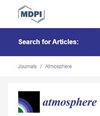在当地监测数据有限的印度非正规住区附近建立空气质量模型
IF 2.3
4区 地球科学
Q3 ENVIRONMENTAL SCIENCES
引用次数: 0
摘要
世界正日益城市化,移民率往往超过了发展中国家城市的基础设施能力。因此,许多移民必须居住在缺乏民用和健康保护基础设施(包括空气质量监测)的非正规住区。在此,我们利用地理空间反距离加权法和中央污染控制委员会(CPCB)2018 年至 2021 年邻近站点的空气质量存档数据,估算了印度德里五个非正规居住区在 2020 年大流行封锁期间的空气状况。结果显示,尽管大流行期间空气质量有所改善,但PM2.5和二氧化氮经常超过世界卫生组织的限值。季风季节的空气质量始终较好(PM2.5 和 NO2 分别为 44.3 ± 3.47 和 26.9 ± 2.35 μg/m3),而季风后季节的空气质量最差(PM2.5 和 NO2 分别为 180 ± 15.5 和 55.2 ± 3.59 μg/m3)。居民点之间空气质量的差异是由于距离主要道路和露天焚烧场所较近,道路附近的二氧化氮水平通常较高,而露天焚烧场所附近的 PM2.5 水平较高。2023 年,在三个居民点和当地的 CPCB 站进行了实地监测。居民点和距离最近的监测站的空气质量差异不大(P < 0.01)。然而,实地数据显示,居住区内的现场因素(如烹饪、临时燃烧或微型工业)会影响当地范围内的空气质量,这表明非正规居住区的健康风险更大,因为那里有更多不受管制的活动。城市尺度模型可以估算未监测地点的平均空气质量浓度,但需要谨慎,因为此类模型可能会遗漏可能对当地健康影响最大的当地暴露。本文章由计算机程序翻译,如有差异,请以英文原文为准。
Modeling of Air Quality near Indian Informal Settlements Where Limited Local Monitoring Data Exist
The world is becoming increasingly urbanized, with migration rates often exceeding the infra-structural capacity in cities across the developing world. As such, many migrants must reside in informal settlements that lack civil and health protection infrastructure, including air quality monitoring. Here, geospatial inverse distance weighting and archived Central Pollution Control Board (CPCB) air quality data for neighboring stations from 2018 to 2021 were used to estimate air conditions in five informal settlements in Delhi, India, spanning the 2020 pandemic lockdown. The results showed that WHO limits for PM2.5 and NO2 were exceeded regularly, although air quality improved during the pandemic. Air quality was always better during the monsoon season (44.3 ± 3.47 and 26.9 ± 2.35 μg/m3 for PM2.5 and NO2, respectively) and poorest in the post-monsoon season (180 ± 15.5 and 55.2 ± 3.59 μg/m3 for PM2.5 and NO2). Differences in air quality among settlements were explained by the proximity to major roads and places of open burning, with NO2 levels often being greater near roads and PM2.5 levels being elevated near places with open burning. Field monitoring was performed in 2023 at three settlements and local CPCB stations. Air quality at settlements and their closest station were not significantly different (p < 0.01). However, field data showed that on-site factors within settlements, such as cooking, ad hoc burning, or micro-scale industry, impact air quality on local scales, suggesting health risks are greater in informal settlements because of greater unregulated activity. City-scale models can estimate mean air quality concentrations at unmonitored locations, but caution is needed because such models can miss local exposures that may have the greatest impact on local health.
求助全文
通过发布文献求助,成功后即可免费获取论文全文。
去求助
来源期刊

Atmosphere
METEOROLOGY & ATMOSPHERIC SCIENCES-
CiteScore
4.60
自引率
13.80%
发文量
1769
审稿时长
1 months
期刊介绍:
Atmosphere (ISSN 2073-4433) is an international and cross-disciplinary scholarly journal of scientific studies related to the atmosphere. It publishes reviews, regular research papers, communications and short notes, and there is no restriction on the length of the papers. Our aim is to encourage scientists to publish their experimental and theoretical research in as much detail as possible. Full experimental and/or methodical details must be provided for research articles.
 求助内容:
求助内容: 应助结果提醒方式:
应助结果提醒方式:


